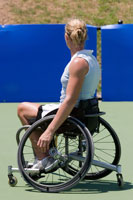Section navigation
Gear for sports and fitness

Disabilities shouldn't limit the things you enjoy doing. Many devices make it possible to join in sports and other physical activities. Tools that help people with disabilities lead more independent lives are known as assistive technology (AT). Below are some of the assistive technology devices for playing sports and working out:
- Light-weight wheelchairs for basketball, tennis, and racing
- All-terrain wheelchairs with rugged frames and wheels for rolling over unpaved surfaces, like hiking trails
- Softballs that beep, so that people with vision problems can locate the ball to hit and catch it
- Handcycles, which are like bicycles but you pedal and steer using only your arms
- Cross-country sit skis that allow you to sit down and push yourself along the trail with tips that dig into the snow
- Basketballs with jingle bells inside for people who have limited or no sight
- Weights that you strap on your wrists if you can’t hold them in your hands
- Gym equipment that lets you stay in your wheelchair while using arm exercise machines
- Mitts with Velcro straps that help you hold onto an exercise machine if your grip isn’t strong enough
- Elastic band or tubes that exercise your muscles through resistance instead of weight
Need help finding equipment? You can:
- Check out a website that provides information on tools that help with sports and many other activities.
- Find a list of websites that sell fitness equipment for people with disabilities.
- Look at home exercise machines online.
- Contact a Center for Independent Living, which is a community-based group that helps people with disabilities, about local sources.
Assistive technology can be expensive. If you need help, here are some options:
- If you have health insurance, it may pay for some types of assistive technology.
- Centers for Independent Living, community-based groups that help people with disabilities, may have suggestions for funding sources or for organizations that lend equipment.
- Each state has an Assistive Technology Program. You can find your AT office and ask if they know of local or state funding support or nonprofits that can help
- If you get help from professionals like a special education teacher, physical therapist, or vocational rehabilitation specialist, they may know of funding opportunities.
- Some areas have AT exchanges, where people swap items they’re not using or sell them at lower prices.
- Organizations that focus on specific disabilities such as cerebral palsy, blindness, and other conditions may offer financial help for assistive technology.
- Parent Training and Information Centers, which help parents of kids with disabilities, may have suggestions.
Content last reviewed February 16, 2011
Page last updated October 31, 2013







